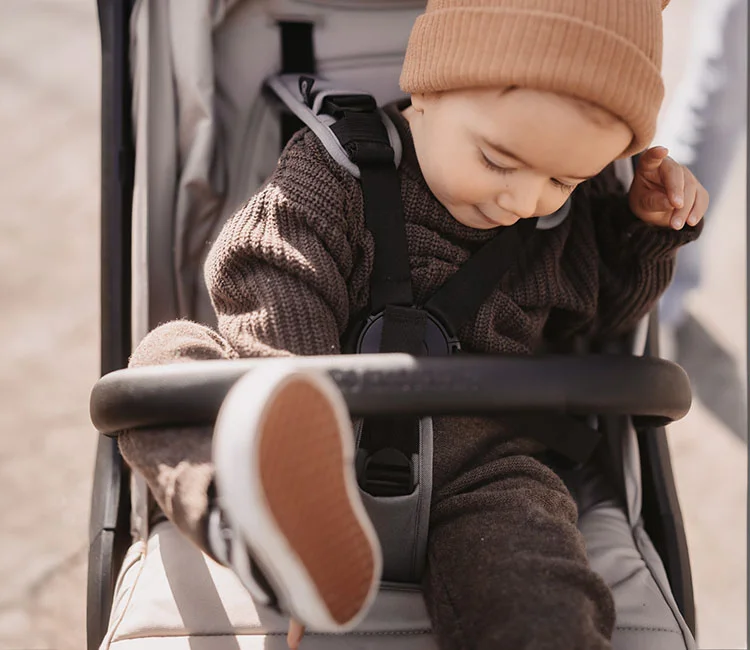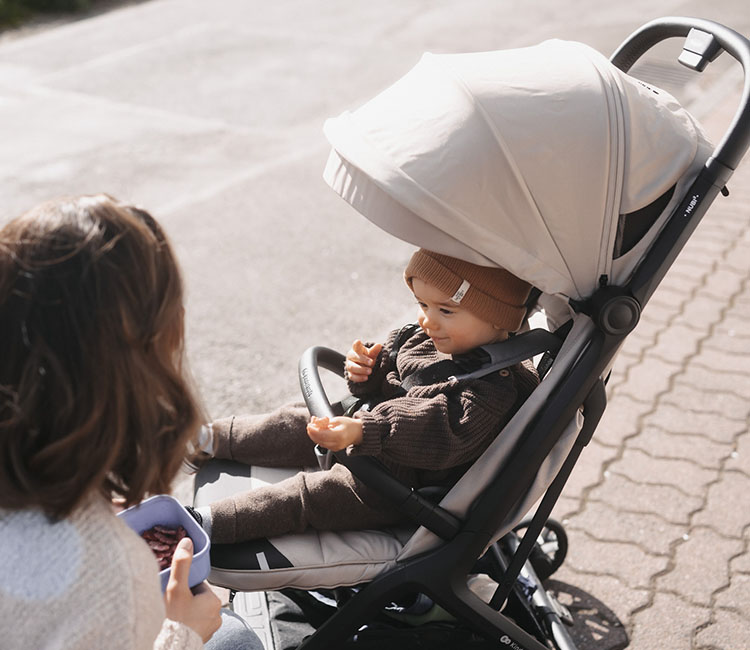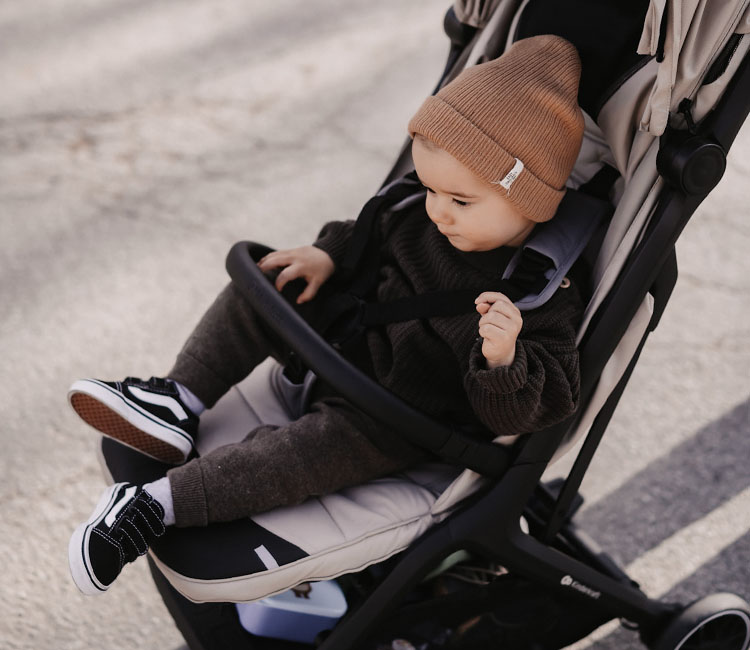How to dress your child for autumn and winter walks?
Reading time: 6 minutes

As autumn approaches, parents, especially fledgling ones, face the dilemma of how to dress their child for a walk? Let's be honest - the weather does not spoil. In September, and even until mid-October, temperature fluctuations of 12-20°C can occur in a matter of just a few days. Adults struggle to dress themselves, not to mention newborns or toddlers who go to the nursery or kindergarten. And that's when on top of everything mentioned above institutions send a message causing additional anxiety. "Please, dress your children according to the weather" - but what does that mean?
In this article, we will guide you on how to dress your child for an autumn and winter walk, and what to pay attention to in order to avoid overheating or chilling your little one. We will also share with you a few tips thanks to which you will always be prepared for any situation - without carrying five bags of additional clothes with you.
What are the risks of overheating the child?
Let's start with the key information: how to dress a child for a walk depends on their age. Dressing a newborn is different from dressing a preschooler who is playing on the playground, running, and jumping with their peers.
A newborn doesn't move around as much, so their body doesn't generate the amount of heat as older children do, so automatically we dress them more warmly to prevent them from getting chilled. Unfortunately, this often leads to overheating of newborns, especially in cooler seasons. As soon as the weather turns its aura to autumn, famous questions start to arise: "Where's the hat?" or comments like "Put on some socks, his feet are cold." "Helpful advice" given to us by close ones (and strangers too) combined with the knowledge that a baby can't warm up on their own, often results in over-layering, which can lead to overheating the baby. However, we must remember how dangerous this can be and the serious consequences it can have. It can lead to high fever, chills, extreme exhaustion, weakness, thermal shock, and disturbances in consciousness. Overheated children are also more susceptible to infections.
We need to realize that it's better to dress the child a bit lighter than too warm. Older children walk and run a lot, while younger ones lie in the carrycot, which protects them from the wind and also raises the temperature inside the pram. Additionally, the hood also provides extra protection, especially if it unfolds, as in models like NUBI 2 or ROUTE.

How to dress your child for a walk during autumn and winter?
You already know that prams and strollers protect the child from the wind. So, how to choose a child's outfit for the outside weather? Of course, start by checking the temperature, If it's -20°C, then it's obvious it is better to stay at home. However, the problem arises when the temperature fluctuates between 0-14°C. Should you put on a hat? Should you wear insulated pants? Or maybe put on warm shoes for your child?
First of all, check the weather, not just the temperature. Step out onto the balcony or open a window. Check if it's windy and if it’s a warm or cold wind. Is there a chance of rain? Or perhaps snow? Adjust your outfit to the current weather - make sure you feel warm. This leads us to the next point.
Secondly, dress your child in one more layer than you wear. This is an easy rule to remember and apply every day. If you're wearing a short-sleeved shirt and long pants, why would you dress your child in a thick wool sweater, booties, and a hat? The golden rule is: one layer more than us! Remember that one layer refers not only to a shirt, blouse, or sweater/jacket but also to a blanket or sleeping bag. This way, you can always remove one or two layers if the sun suddenly comes out and it gets warm.
Thirdly, always carry a blanket or an extra outer layer with you. For younger children and infants, it's enough to have a blanket or a half-sleeping bag in the stroller basket under the seat. For older children, take an extra vest, sweater, or light jacket - that will be sufficient. Don't worry, doctors have long debunked the myth of a child getting sick from mythical "draughts".
The best approach is to layer up once dressing the children. This way, you can easily remove or add a layer if your child is too cold or too warm. Remember: dress the newborns in one more layer than yourselves (for example, dress them like you and cover with a blanket instead of putting on a puffy jacket in autumn) and take into account that they are protected by the pushchair. For older children, layering up works even better - they can take off their jumper while playing on the playground, and when you're heading back home, just put it back on if it's windy and cold.

But what about the famous hat? It’s not so simple in this case. We lose a lot of heat through our heads, so wearing a hat in low temperatures is particularly important for children and the elderly. Additionally, in the case of children, the area of their heads is much bigger than that of an adult (the younger the child, the larger the head - it's only with time that a child's proportions change). Remember, however, that we still need to be able to cool down somehow. That's why it's good to put on a (thin cotton) hat for infants at 13-14°C or lower. When the temperature gets closer to 0 and your ears start to feel cold, put on a warmer hat for your child and yourself. Older children may or may not inform you if they're feeling cold. Here, you'll have to rely on your instincts or dress them as you dress yourself. Do you have a scarf and hat because it's windy? Put them on your preschooler too. Don't have them because the wind is warm and pleasant, and the sun has come out from behind the clouds? Skip it.
Also, remember not to put shoes on non-walking children. Socks or insulated booties are completely sufficient for them. Putting on stiff shoes can have a negative impact on the development of their feet!
How do you check if your child is too warm?
Alright - but what if we're not sure if the child is dressed properly? There's one way that can help you check if the child's body temperature is appropriate. You should touch the back of the child's neck: if it feels cold, the child might be too cold, and if it's warm, they might be too warm.
Checking the body temperature by touching the hands and feet is not very reliable because these are exposed parts of the body that are most affected by the weather conditions. That's why a child might feel comfortable overall but still have cool hands - just like us, adults. If the back of the neck feels fine, there's no need to add an extra jacket or blanket.

Does the composition of baby clothes matter?
Of course. Some parents follow the principle that children grow quickly, so they buy them inexpensive clothes. There's nothing wrong with that, but it's still worth paying attention to the fabrics used in such clothing. For example, cotton clothes are affordable and allow the skin to breathe.
Natural fabrics like cotton or wool facilitate the body's temperature regulation, so it's a good idea to buy clothing made from them. This will make it easier to dress your child: instead of using a bodysuit, a shirt, a fleece, and then a jacket, you might find that a bodysuit and a wool sweater, or a jacket lined with natural fabric, are sufficient.
Also, remember that the weather-related labels on clothes do reflect reality. Waterproof jackets protect against rain, and windproof ones shield from the wind. So, they are useful in the right conditions. Insulated jackets and shoes are perfect for very cold temperatures. When clothing is labeled as breathable, it means the fabric allows air to pass through and helps regulate your child's body temperature.
And what to do when the frost bites?
The hat, scarf, gloves, and overall are already on, but the child is crying or complaining about the biting cold on their face? Here it's worth following the advice of our grandmothers, which means applying a thick cream to the face. However, let’s make sure that it is a cream of a good formulation. The less water it contains, the better. It's also good if the formula is not too complicated - before applying the cream to your child's face, be sure to test their reaction to the purchased cream a day or two in advance, preferably on the inside of the elbow. Some cosmetics can cause allergies in children, and applying them to the face can trigger a strong allergic reaction.
It's best to apply the rich cream for winter 15-20 minutes before going out.
You already know how to dress your child for autumn and winter walks. You know the risks of overheating and how dangerous it can be for a child. And most importantly, you know how to check if your child is too warm or too cold. We hope our advice will allow you to enjoy walks without stressing about how to dress your child.
